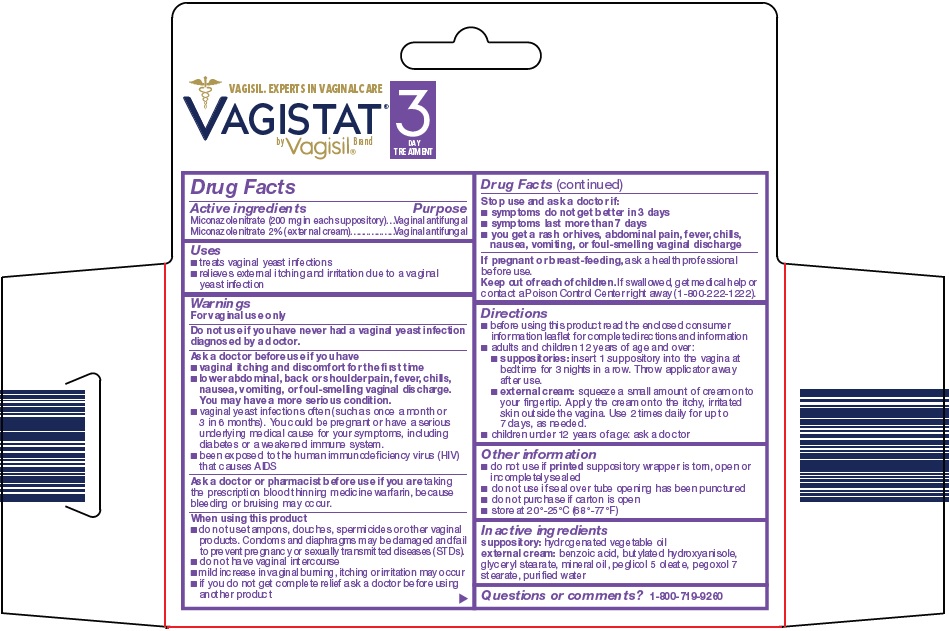Vagistat 3 | Miconazole Nitrate Kit while Breastfeeding

What is Vagistat 3 | Miconazole Nitrate Kit used for?
Brief: Vaginal antifungal
Vagistat 3 | Miconazole Nitrate Kit while breastfeeding safe or not? Can there be any side effects for infant while using it during breastfeeding?

Vagistat 3 | Miconazole Nitrate Kit Breastfeeding Analsys
Miconazole nitrate while Breastfeeding
SafeCAS Number: 22916-47-8
Excretion into breast milk is highly unlikely due to an almost nil systemic absorption through the skin, vaginal mucosa and even the intestine, with non-significant plasma levels (< 1 mcg/ mL) observed. In case of use on the nipple, let it be done after the feed and wipe it out any excess of cream before the next feed. Do not apply creams, gels and other products that would contain paraffin (mineral oil) to avoid absorption by the infant since it is a hydrocarbon-derived substance. Miconazole has not been found to be more effective than pure lanolin for treatment of sore or cracked nipples. List of Essential Medicines by WHO 2002: compatible with breastfeeding.
Miconazole nitrate while Breastfeeding
SafeCAS Number: 22916-47-8
Excretion into breast milk is highly unlikely due to an almost nil systemic absorption through the skin, vaginal mucosa and even the intestine, with non-significant plasma levels (< 1 mcg/ mL) observed. In case of use on the nipple, let it be done after the feed and wipe it out any excess of cream before the next feed. Do not apply creams, gels and other products that would contain paraffin (mineral oil) to avoid absorption by the infant since it is a hydrocarbon-derived substance. Miconazole has not been found to be more effective than pure lanolin for treatment of sore or cracked nipples. List of Essential Medicines by WHO 2002: compatible with breastfeeding.
Vagistat 3 | Miconazole Nitrate Kit Breastfeeding Analsys - 2
Miconazole nitrate while Breastfeeding
CAS Number: 22916-47-8

Because miconazole has poor oral bioavailability, it is unlikely to adversely affect the breastfed infant, including topical application to the nipples. However, miconazole ointment appears to have no advantage over lanolin for treating sore nipples during breastfeeding[1] and a survey of members of the Academy of Breastfeeding Medicine found topical miconazole is rarely prescribed to nursing mothers to treat thrush.[2] Any excess cream or ointment should be removed from the nipples before nursing. Only water-miscible cream or gel products should be applied to the breast because ointments may expose the infant to high levels of mineral paraffins via licking.[3]
Miconazole nitrate while Breastfeeding
CAS Number: 22916-47-8
Because miconazole has poor oral bioavailability, it is unlikely to adversely affect the breastfed infant, including topical application to the nipples. However, miconazole ointment appears to have no advantage over lanolin for treating sore nipples during breastfeeding[1] and a survey of members of the Academy of Breastfeeding Medicine found topical miconazole is rarely prescribed to nursing mothers to treat thrush.[2] Any excess cream or ointment should be removed from the nipples before nursing. Only water-miscible cream or gel products should be applied to the breast because ointments may expose the infant to high levels of mineral paraffins via licking.[3]

What if I already have used Vagistat 3 | Miconazole Nitrate Kit?
Vagistat 3 | Miconazole Nitrate Kit is safe in breastfeeding and should not create any health problem for your baby but in case you feel any health issue associated with Vagistat 3 | Miconazole Nitrate Kit you should contact your doctor or health care provider. Be it pregnancy or lactation you shall keep your doctor informed.
I am nursing mother and my doctor has suggested me to use Vagistat 3 | Miconazole Nitrate Kit, is it safe?
Definitely, Vagistat 3 | Miconazole Nitrate Kit is safe in lactation for baby. No wonder your doctor has recommended it.
If I am using Vagistat 3 | Miconazole Nitrate Kit, will my baby need extra monitoring?
No extra baby monitoring required while mother is using Vagistat 3 | Miconazole Nitrate Kit
Who can I talk to if I have questions about usage of Vagistat 3 | Miconazole Nitrate Kit in breastfeeding?
US
National Womens Health and Breastfeeding Helpline: 800-994-9662 (TDD 888-220-5446) 9 a.m. and 6 p.m. ET, Monday through Friday
UK
National Breastfeeding Helpline: 0300-100-0212 9.30am to 9.30pm, daily
Association of Breastfeeding Mothers: 0300-330-5453
La Leche League: 0345-120-2918
The Breastfeeding Network supporter line in Bengali and Sylheti: 0300-456-2421
National Childbirth Trust (NCT): 0300-330-0700
Australia
National Breastfeeding Helpline: 1800-686-268 24 hours a day, 7 days a week
Canada
Telehealth Ontario for breastfeeding: 1-866-797-0000 24 hours a day, 7 days a week
